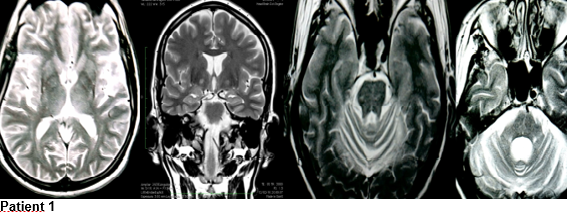Category: Neuroimaging (Non-PD)
Objective: Describe patients with Multiple System Atrophy with iron accumulation in neuroimaging of striatal regions.
Background: MSA is an adult neurodegenerative disease with parkinsonism, cerebelar ataxia and autonomic failure.
Neurodegeneration with Brain Iron Accumulation diseases (NBIA) are neurodegenerative diseases, as the Pantothenate Kinase-Associated Neurodegeneration (PKAN), with a very distinct pattern on neuroimaging, known as the “Eye of the Tiger Sign”.
This sign are rare in the MSA but there are many studies confirming the role of striatal regions iron accumulation in the parkinsonisms.
Method: We report 2 cases from Movement Disorders Clinic at Universidade Estadual Paulista – Brazil.
Results: 62-year-old male patient with 5 years bradykinesia and stiffness progressing to wheelchair, REM sleep behavioral disorder, no improvement with levodopa, disarthrophonia and choking requiring gastrostomy after 3 years, associated to syncope episodes. Neurological examination showed blood pressure of 105x80mmHg lying down and 80x60mmHg standing up, severe disarthrophonia, anterocapitis, severe global parkinsonism, postural instability and ataxia. Magnetic Resonance Imaging showed the “Eye of the Tiger”, “putaminal rim” and the “hot cross bun” signs.
78-year-old male with syncope episodes. He has about 1.5 years of slow walking, falls, difficulty moving hands and feet and constipation. No improvement with levodopa. Neurological examination showed blood pressure of 130×80 mmHg lying down and 90×60 mmHg standing up, severe bradykinesia and stiffness, drooling, appendicular and axial ataxia and “square-wave jerks”. Investigation for metabolic, paraneoplastic and inflammatory causes was normal and magnetic resonance imaging showed bilateral “Eye of Tiger Sign”, bilateral “putaminal rim sign” and cerebellar atrophy.
Conclusion: Both cases fulfilled criteria for the diagnosis according to the Second Consensus in Diagnosis of MSA, as a sporadic, progressive disease in adults with autonomic failure, parkinsonism and cerebellar ataxia, after excluding other diseases.
PKAN disease presents with parkinsonism and other movement disorders (especially dystonia), and neuropsychiatric symptoms, with typical radiological sign – the “Eye of the Tiger sign” – but other diseases may show the same pattern, such Wilson’s disease, Multiple System Atrophy and Corticobasal Degeneration.
We emphasize the importance of knowing this variation of MSA to avoid diagnostic confusion.
References: 1 – Gilman S, Wenning GK, Low PA, et al. Second consensus statement on the diagnosis of multiple system atrophy. Neurology 2008; 71: 670) 2 – Ikeda, T., Matsuo, Y., Ueda, A., & Hirano, T. (2012). Pseudo eye of the tiger sign in atypical parkinsonism. Neurological Sciences, 34(5), 777–778. 3 – Strecker, K., Hesse, S., Wegner, F., Sabri, O., Schwarz, J., & Schneider, J.-P. (2007). Eye of the Tiger sign in multiple system atrophy. European Journal of Neurology, 14(11), e1–e2. 4 – Wang, Y., Butros, S. R., Shuai, X., Dai, Y., Chen, C., Liu, M., Xu, H. (2011). Different Iron-Deposition Patterns of Multiple System Atrophy with Predominant Parkinsonism and Idiopathetic Parkinson Diseases Demonstrated by Phase-Corrected Susceptibility-Weighted Imaging. American Journal of Neuroradiology, 33(2), 266–273.
To cite this abstract in AMA style:
I. Teixeira, S. Trivellato, I. Fonseca, D. Margato, R. Bazan, A. Schelp. An Eye of a Tiger cannot see all the true: a case series. [abstract]. Mov Disord. 2021; 36 (suppl 1). https://www.mdsabstracts.org/abstract/an-eye-of-a-tiger-cannot-see-all-the-true-a-case-series/. Accessed April 2, 2025.« Back to MDS Virtual Congress 2021
MDS Abstracts - https://www.mdsabstracts.org/abstract/an-eye-of-a-tiger-cannot-see-all-the-true-a-case-series/


